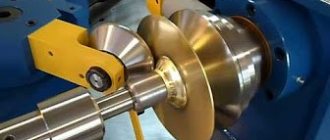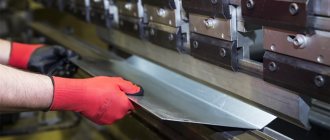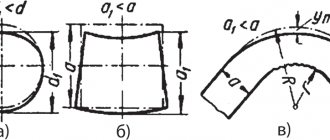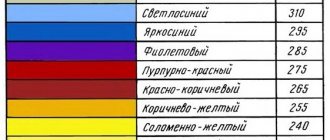Metal drawing and its types
Main types of rotary metal drawing:
Step molding
A sheet blank in the shape of a circle is fixed between the mandrel and the support. The mandrel must match the internal configuration of the product. The drive begins to rotate the blank, and controlled forming pressure is carried out by a special passive roller driven by the rotation of the blank. Pressure is applied in both longitudinal and radial planes. The roller presses the metal against the mandrel and moves along a complex curve, either towards the edge of the blank or back.
The clamping is carried out in several passes, in steps. At the end of the treatment, a series of smoothing movements of the roller are carried out with reduced pressure to obtain a high-quality surface.
Projection - One-Pass Molding
Extraction is carried out in one pass. The roller moves parallel to the mandrel, depending on the angle of its installation, the wall of the blank is thinned more or less, its material moves under the influence of the roller in the axial direction.
Projection - One-Pass Molding
The method is characterized by efficiency and dimensional accuracy, as well as a high class of the resulting surface.
Rolling with or without mandrel
In this case, the outer diameter of the workpiece is reduced with a simultaneous thickening of its wall due to the redistribution of the material. Rolling is carried out towards the center, in several passes.
Rolling with or without mandrel
As an option, the part is formed by individual segments of the mandrel using a roller with an offset center. Cutting, additional profiling or flanging are carried out as final operations.
Combined
For parts with complex configurations, stepwise forming, rolling, profiling and cutting are used together in various combinations.
Rotary metal drawing process
As a rule, a sheet plate in the shape of a circle is used as a blank. In addition, for some parts other flat shapes are used - an oval or an ellipse, as well as complex curvilinear closed contours. Blanks are also used - sections of pipes, most often round.
Preparatory operations for unique parts and small series are performed on round cutters. In the case of large series, cutting is more efficiently performed on hydraulic cutting machines, due to the fact that laser or plasma cutting is associated with high temperature exposure in the cutting area. This may impair the ductility of the material.
Advantages of the metal drawing technique
There are two main methods of rotary drawing: direct and reverse. Both options have the following advantages:
- workflow automation;
- accuracy of manufacturing parts that repeat the profile (workpiece);
- permissibility of production of small and large batches of goods;
- reducing production cycles and increasing enterprise productivity;
- reduction of material consumption, which reduces the final cost of products;
- finished parts have high strength and uniform structure;
- low cost of purchasing consumables.
Thanks to the rotary drawing technology, ideal shapes are obtained that act as blanks for further jewelry creation. In addition to the jewelry industry, machines are used for the production of metal parts and blanks for various industries.
Areas of application of rotary drawing technology
Most often, machines for rotary drawing of metal are installed in the space and aviation fields. And also in the field of shipbuilding and mechanical engineering, the automotive and chemical industries, energy and for the creation of parts for radio equipment and electronics. The equipment is often used in jewelry on an industrial scale to produce unique batches of goods on time.
Almost any metal can be used as a workpiece; aluminum, brass, bronze and copper are most often used due to their flexibility and ductility. Precious metals can also be processed by drawing.
Methods for rotary drawing of metal
The variety of techniques for rotary drawing of metal comes down to one of two types:
- Straight. The metal moves along the forming roller.
- Back. The metal moves against the movement of the forming roller.
Direct method
The outer contour of the punch corresponds to the inner contour of the future product (taking into account the necessary allowances). Because of this, the mandrel is made longer than the product. The design of the punch becomes more complicated, the weight, cost and labor intensity of debugging the technological process increases.
Direct method of rotary drawing of metal
This method is applicable for molding parts in the form of a cone and cylinder with a large ratio of length to diameter and diameter to wall thickness.
Back
In this case, the mandrel must match in size and shape with the inner surface of the workpiece, which makes it possible to make the mandrel much shorter than the future product.
Thick-walled rotary hood
The method is used in the production of products with a small length-to-diameter ratio and relatively thick walls.
Rotary metal drawing operations are also divided into forming:
- With thinning, the outer size is maintained, the wall thickness is reduced.
- Without thinning - the wall thickness is maintained during processing, but the outer diameter changes.
- With rolling, the outer diameter is maintained, the wall thickness increases.
Main types of rotary metal drawing
The workpiece is secured between the mandrel fixed to the drive and the caliper clamp.
Machines for rotary drawing of metal
To implement the technology, the following types of machines are used:
- Pressing and rolling machines for rotary drawing of metal.
- Rotary forging machines.
- Round cutters.
On manual lathes, molding is performed by the muscular strength of the worker. Used to produce unique products or especially small series. For medium and large series, pressing and rolling (rolling) machines with numerical control are used. Hydraulics or electric drives, controlled by a controller according to a program loaded into the central CNC unit, allow precise control of the force and direction of the clamp, as well as the direction of movement of the roller, including the most complex curved trajectories. Such machines ensure absolute identity of products in a series, which is especially important for jet engine parts and other high-tech products
Scheme of forging on rotary machines
Rotary forging machines allow you to form conical-shaped products from pipes by crimping the pipe with a special tool - a forging die. The peculiarity and main advantage lies in the unique ability to produce products that have:
- the length is many times greater than the diameter.
- along the length, the diameter and opening angle of the cone can be repeatedly changed.
- knurling of stiffeners is required.
Circular cutters are designed for cutting rolled sheets into flat pieces in the shape of a circle or ellipse. Also used are both manual and electro-hydraulic.
Do-it-yourself rotary hood or “pressure”
Profi Pressing and rolling machines, Club "PROFI" →
12/15/2012 stangroup
A tool for working on a pressing and rolling machine or for rotary drawing of non-ferrous metals on any lathe looks like this:
The duck nose or sheep nose are most actively used in work, although this largely depends on what kind of product is being rolled out. And the simplest tool to make to begin your exploits in winepressing looks like this:
It can be made from tool steel round timber 16..30mm, depending on what machine you will work on and what dimensions your product will be. Using a sharpening machine or grinder, give the tip the required shape, grind, harden and polish to a mirror surface. All flaws and shortcomings after grinding and polishing the tool will be transferred and multiplied on the workpiece in work! An unhardened tool will quickly acquire surface damage - scratches and spoil the surface of the workpiece. When working with such a tool, for obvious reasons, it is necessary to use lubricants. You can use stamp lubricant, wax, soap (for aluminum), etc. The main task is to ensure sliding, the longest possible stay of the lubricant on the workpiece during work and the ease of cleaning it after finishing work.
The next step in mastering the “pressure” with your own hands can be a straight hand tool with roller attachments:
It is necessary for rolling sharp corners (using triangular rollers), rolling edges and flanging (using rollers with a groove on the surface), in addition, it can be used to work not only with non-ferrous metals, but also with harder black metals (according to ability to draw cold-rolled steel up to 2 mm thick, strength groups K260V, K270V, K310V, K330V, K350V - deep - G, DX53D - Molded steel, corrosion-resistant, quality for deep drawing, DX54D - Molded steel, corrosion-resistant, quality for extra deep drawing hoods, DX56D - Molded steel, corrosion-resistant - Quality for extremely deep drawing, etc.), stainless steel. (304), etc... (the leftmost tool in the photo is equipped with a carbide tip and is used for trimming edges).
A tool for working with ferrous metal must be more powerful. Pressing steel with a thickness of 1 mm or more without a lever is quite a labor-intensive task, not to mention working with metal 2 or 3 mm thick, and even more so with stainless steel. Also, the pressure tool for working with h/m must be roller, because the hardness of the workpiece becomes close to the hardness of the tool, and the forces applied during rolling increase significantly and as a result, when you try to roll out with a simple tool, it heats up, becomes damaged and damages the workpiece. In addition to the actual lever used to increase the operator’s pressure on the part, such a tool allows you to not have to worry about holding the rolling roller in a vertical position, reduces runout, and the increased weight of the tool rests on the support stand.
As an example, I will give a drawing and photographs of a finished lever tool for pressing and rolling. You can modify and optimize it to suit your needs and at your own discretion:
Support stand:
Pressing lever with roller + “fingers”
Swing arm:
Photo of the finished tool:
To make work easier, this tool is also good for working with non-ferrous metals. The disadvantages of a tool with a lever would be that it is less sensitive, so when working with silver jewelry, it is better to use a straight tool.
Various models of pressing and rolling machines can be viewed here.
Also see the article about composite mandrels for the production of “closed” forms using a rotary hood
To the beginning of the article...
Tags: pressing and rolling machines pressure tool rotary hood rotary hood
23233
+2
Scope of application of rotary metal drawing
The method is used to produce:
- jet engine parts in weapons systems;
- tank bottoms and covers;
- various screens in radio engineering, including radar screens;
- thin-walled vessels of complex shape: cans, teapots, cylinders, kettles;
- parts of construction mixer bodies;
- parts of fans and exhaust hoods.
Products made by rotary drawing
The method is also used in the production of contemporary art objects and in the studio for customizing unique motorcycles and cars.
Areas of application and materials used for the manufacture of rotary hood parts
First of all, parts manufactured using RV technology have found wide application in the space and aviation industries, shipbuilding and mechanical engineering, in the automotive and chemical industries, in power engineering and communications.
In aviation, parts for fairings and air intakes, fuel tanks, high-pressure cylinders, combustion chambers, etc. are manufactured using RV technology.
For the production of parts, almost any metals and alloys are used; aluminum and its alloys, non-ferrous metals and alloys (brass, bronze, copper), heat-resistant steels of various grades, alloy steel, titanium and its alloys are widely used.
What are the features of CNC pressing and rolling machine?
Would you like to know more about CNC press-forming machines? Find out about rotary hoods, classification, features and advantages of such units.
Pressing and rolling machines with numerical control are equipment used for processing sheet metal blanks. Pressing and rolling processing of a roller is a modern method carried out on CNC pressing and rolling machines.
This method involves the use of devices that have hydraulic and electro-hydraulic supporting parts of the metal-cutting device. They move the pressure rollers, which are the main tools in the processing of parts.
What is a rotary hood
A method for processing sheet-type metal products, in which a three-dimensional part is transformed into a hollow one with an axisymmetric appearance, is called rotary drawing. It involves significant deformation and thinning of the walls of the spare parts. This method of processing sheet metal by drawing has ancient roots. In modern manipulation of steel blanks, it is carried out by a pressing and rolling machine.
Using the rotary drawing method, these devices are capable of producing household items with thin walls and complex shapes. A set of such devices is presented:
- teapots;
- scoops;
- sponges;
- vessels;
- coffee pots.
Classification of CNC machine tools
Pressure-rotary drawing has many of the properties and functions of turning analogues. In contrast, pressure-rotary devices have a higher operating speed. There are three types of devices of this type:
- manual tabletop;
- manual floor;
- with a rotary hood.
Rotary drawing is accompanied by additional actions such as rolling, expanding and welding. The rolling machine is capable of both producing a solid part using the rolling method, and completing the drawing and production of spare parts made using other equipment. The most popular products of this kind, for example, are tubular spare parts with various combinations of cross-sections.
The machines can be used not only for processing metal parts, but also copper ones that have a conical shape. The advantage of CNC devices is that the process is less labor-intensive than using presses. Modern technologies make it possible to monitor the operation of devices remotely. Round metal plates are used as the main raw material for working on a rotary pressing machine.
But the devices can also cope with workpieces that have a more complex geometric shape. Additional methods of working with the product are circular and hydrojet cutting. Examples of plasma and laser cutting in this case are less effective, since they can increase the temperature, which will change the plastic qualities of the spare part.
Main advantages of RV technology
Traditional metal processing technologies such as forging, casting or stamping do not have the advantages that RV has. In the process of processing parts using RV technology, significant savings in time and money can be achieved. The advantages of RT technology usually include:
- Automated RV machines have high productivity, especially when it comes to the operation of forming cones.
- The part completely follows the profile and requires almost no additional processing.
- Even the production of small or pilot series of parts proves the maximum economic efficiency of RV technology.
- RV technology can significantly reduce the production cycle.
- RV technology makes it possible to significantly speed up the process of manufacturing any batches of parts of the most complex shape; traditional metal processing methods such as forging or casting are inferior in many respects.
- When manufacturing parts, material consumption is significantly reduced.
- The technology makes it possible to produce parts from blanks with a thickness close to the thickness of the part walls.
- Devices and tools have low cost, increased strength and low weight.
- The equipment and tools used in the manufacture of parts using RV technology are more cost-effective in comparison with the tools and equipment used in traditional metal processing.
- There is no need to produce stamps and injection molding models, which typically require the use of expensive materials and manual labor.
- Parts after manufacturing using RV technology have increased strength and a homogeneous structure.
- Thanks to this, it is possible to significantly increase the service life of not only the part, but also the assembly unit as a whole.
- The equipment can be quickly reconfigured to produce another part. One workplace allows you to perform several operations, thanks to which the full processing cycle is significantly reduced.
- There is no need to use a large amount of equipment and special equipment for each technological transition.
Quite low cost of the preparatory cycle for manufacturing a part. If production is pilot or small-scale, then its economic efficiency is maximum.
Advantages of machines of this type
All types of rotary pressing machines have the same principle of use. The roller tool is the most commonly used. When working with this equipment, it is possible to produce unique spare parts of complex shapes, while simultaneously carrying out equipment. The machine is equipped at a low price. For other types of metal manipulation, the price of equipment will be significantly higher.
Among the main advantages of units with a rotary hood are:
- possibility of mass, small-scale and single production;
- possibility of operation in large and small workshops;
- possibility of manufacturing wooden equipment;
- production of parts for the economic, chemical and food industries;
- economical use.
Possible defects during the metal drawing process
Automated rotary drawing technology produces precise asymmetrical hollow parts. Thanks to the pressure of the roller element on the workpiece, the metal quickly takes the desired shape. For small-scale production, manual lathes are used. In the industrial sector, special pressing and rolling equipment is installed.
However, the use of lathes has a number of disadvantages, which include the need to constantly change workpieces. Manual production results in low speed and low productivity. And also with constant heating of the metal, additional firing is often required to increase its strength.
Features of the package
Models of CNC machines have a high productivity rate. Thanks to numerical control, they have an automatic production mode. By using such a machine, you can provide yourself with a number of advantages. One of them is the presence of two tool rollers, which simultaneously exert increased pressure.
The configuration of the above models consists of examples:
- circle-centering device;
- optional manipulator;
- double type tool head;
- 4+4 positioning mechanism;
- hydroelectric power stations;
- additional roller with a compensator.
The thickness of aluminum blanks for processing should be from 0.6 to 4 millimeters. For steel blanks - from 0.6 to 2.5 millimeters. For workpieces made of corrosion-resistant steel - from 0.6 to 1.5 millimeters. The specified characteristics are relevant only for original models.











